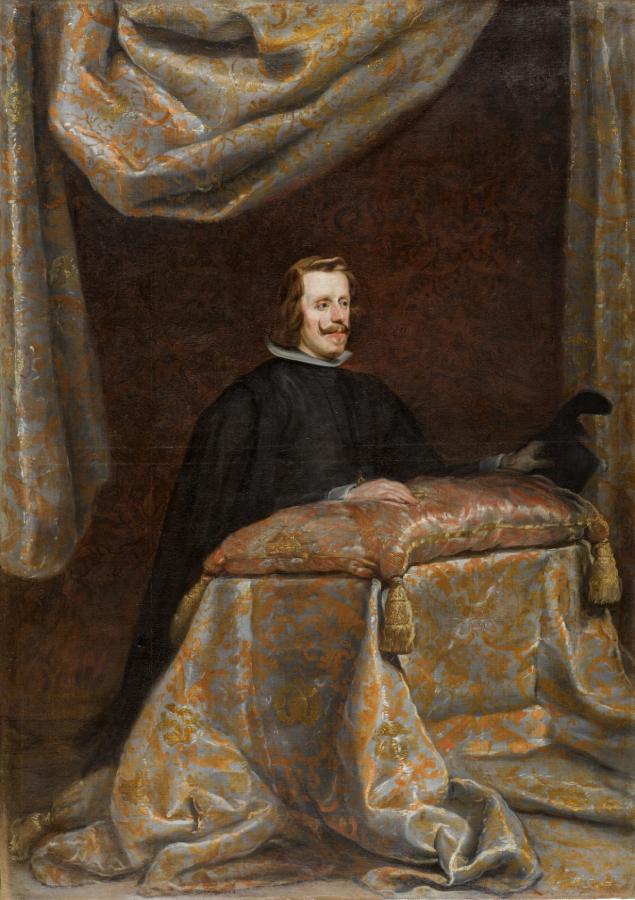Velázquez, Diego (1599-1660)
Felipe IV, orante (Philip IV in prayer)
c.1655
Oil on canvas, 209 x 147 cm
Museo del Prado, Madrid
This pair of portraits (P001220 and P001222) combines several aspects of Spanish portraiture of the Baroque period. In principle, the figures of Philip IV and his second wife, Mariana of Austria, are a continuation of the donor-tradition that goes back to medieval religious painting. The client would be incorporated, kneeling or prostrate in a reverential position, into the religious scene that he or she had commissioned; the portrait of the client manifested his or her devotion, but also his or her privileged financial and social situation. In these portraits of the monarchs, however, the supernatural element has been omitted. The two figures are individualized, life-sized, and in a luxurious setting of drapery, just as in any other court-portrait. The object of their adoration does not figure in the pictorial space, but is, rather, presumably located somewhere between the two portraits, given the figures’ symmetrical pose. That is, the portraits were part of a constructed scene that simulated the king and queen’s constant prayer before an image. This peculiar mixture of court-portrait and votive offering may be explained by the devotional customs of the House of Austria and, more especially, the place for which the portraits were painted: the Monastery of San Lorenzo el Real at El Escorial. The monastery is the principal religious edifice of the House of Austria in Spain, constructed, among other purposes, to house the family burial vaults. At each side of the basilica’s high altar were groups of sculptures portraying the Emperor Charles V, Philip II, and Philip II’s family and most direct line of descendants. The statues, done in bronze by the father-and-son Leonis (Pompeo and Leone), depict the figures in prayer and turned toward the great tabernacle under the altarpiece. Thus, they symbolize the Habsburgs’ perpetual worship and adoration of God and the Church. These groups are the clearest antecedent for the portraits of Philip IV and Mariana at prayer. It was, in fact, Philip IV who completed the construction of the Royal Pantheon, inaugurated in 1654. His association with El Escorial was, thus, very close, and even extended to the paintings and other art used in the building’s main spaces. The king sent some of the most important paintings in the royal collection to the sacristy and chapter rooms, where Velázquez supervised their hanging. In this setting, it is entirely logical that an artist, or royal client, might conceive images that testified to the constancy of Philip IV’s religious constancy and fervor.
Although these paintings clearly came out of the artistic context of El Escorial in the 1650s, many unknowns surround their creation. For example, we do not know the exact place for which they were painted. They are traditionally identified with the portraits of Philip IV and Mariana that were inventoried in the monastery’s Old Church in 1701. In the church’s decorative plan, which was designed by Velázquez, they would have been juxtaposed against the painted versions of the Leoni sculptures that had been done by Juan Pantoja de la Cruz. The funereal and dynastic nature of these canvases becomes even clearer if one realizes that until the Pantheon was completed at El Escorial and the sepulchers of the Spanish Austrians were moved there, the Old Church was where the Spanish monarchs were interred. In the final years of the reign of Philip IV, the walls were adorned with new paintings, but no description of the Old Church during those years speaks of these particular paintings.
Therefore, that location may well have come later. Only a single source testifies to the presence of the portraits of Philip IV and Mariana at prayer in the monastery -specifically in the Chapel of Our Lady of Patronage, which was founded by this king. Apparently they were two small paintings that still remain in the monastery, also by the Velázquez workshop. But once again, this information is long after the fact, since it was published by Antonio Rotondo in the nineteenth century. By that time, the original chapel had been dismantled and moved, and very little is known of its original appearance. Even so, the available facts and the portraits themselves allow us to reach certain conclusions, especially as to the portraits’ clear inspiration by prototypes created by Velázquez. The likeness of Mariana is directly related to the first official portrait Velázquez painted of her (Prado, P01191), which, in addition, hung in the palace area of El Escorial. It repeats the sophisticated hairstyle and clothing of the queen, whose farthingale is hidden by the prie-dieu. The image of the king is not so clearly related to any original by Velázquez, although the Velázquez air is undeniable.
The functioning of the Velázquez workshop during his last years is problematic, although we do know that Juan Carreño, Francisco Rizi, and, of course, Velázquez’ son-in-law Juan Bautista Martínez del Mazo worked in it. Nevertheless, we cannot with any certainty attribute these two canvases to any of them (Text from Aterido, A.: El Greco to Goya. Masterpieces from the Prado Museum, Museo de Arte de Ponce, 2012, pp. 125-126).
See also:
• Felipe IV, King of Spain (1605-1665)
